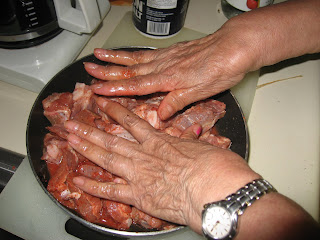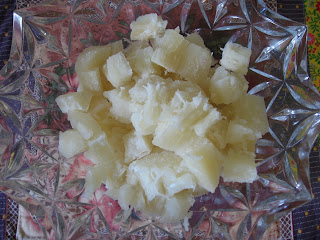Hot Exotic Adventure TONIGHT
Shave cabbage, rub pork ribs, peel yuca and more.
By Lindsay Sterling
Unless you’re a vegetarian or fried-pigskin-intolerant, I have an adventure for you. It requires about 3 hours. It’s exotic, but does not require calling phone numbers in the "relationships" section of your friendly alternative newsweekly. Depending on who you are, it requires little or a lot of bravery. It’s called cooking. You know, that thing people used to do before capitalism infiltrated the home kitchen? Before potato chips and granola bars and mac n’ cheese?
If you have ever described yourself as “not a good cook,” I have theory for you. You think that you are missing the “good cook” or “creativity” gene, but I think it was capitalism, feminism (sorry ladies!), World War II, the industrial revolution, and the digital age that did it. If you were born in America, you probably know how to do what your parents did, which was more than likely serve something that was actually cooked up by their corporate parents, Lean Cuisine, Stouffers, McDonalds, Wendy’s, et al. Those companies cook for one reason, and it’s not to pass on the sheer human pleasure in experiencing the awesomeness of the food.
But that
is why Jenny Sanchez, a Nicaraguan-American, gets up from a horrible night of rheumatoid arthritis pain to hobble around her kitchen and teach me (and therefore you) just how to cook chancho frito and vigoron. (That saying, “share the love,” shows such desperation because if it’s true love, sharing goes without saying.) In this dish, waxy, firm, mildly sweet yuca, dry crispy pork skins, lime-dressed shaved cabbage, and tangy tender fried pork rib bites, all come together right at the end. Any attempt at packaging this dish will fail. It has to be made directly for dear people to eat right now. Shelf life: zero. Table life: about 15 minutes.
So. Are you with me? On this adventure, first we must pack our bags. Go to your town's Latin market (mine is La Bodega Latina, 863 Congress St, in Portland, Maine) to get the following three things. Before you say, "My town doesn't have a latin market," think about what I just said. My town's Latin market bla bla bla MAINE. Now, if online searches come up blank, remember, the web is a know-it-all who does not know it all. Ask the next Spanish speaker you hear.
Achiote Powder. It’s the secret ingredient in the pork. Also known as annatto, it looks and smells like chili powder, but it’s not spicy. It adds tangy flavor and an inexplicable delicious-looking deep orange color to the food. Whole seeds from the achiote tree (Bixa orellana) are also available, but they’re too hard for my coffee grinder. For this dish, definitely buy the powder form, available in small clear packets or a large spice jar.
Yuca. Yuca is pronounced Yoo Ka. It’s a long, hard, thick, brown-skinned root, bigger than a sweet potato but with the same oblong irregular shape. La Bodega seems to always have it. So does Mittapheap international market (61 Washington Ave, Portland, ME) and quite often, the major New England supermarket chain, Hannaford. Don’t get yucca – that’s a cactus-like plant, a totally different species.
Fried Pig Skins. They’re like profound potato chips – salty, fatty, crunchy -- with added animal influence. They come in clear bags. The brand Jenny bought was called Chicharrones, and she got them at Mittapheap (61 Washington Ave, Portland, ME). I’ve seen UTZ, that pretzel company, also sells a variety. I’m working on finding some local pig skin to fry.
Now, here's
the whole recipe. And come to my cooking class Friday night, Oct 9, 2009 at the Freeport Community Center to cook Chancho Frito and Vigoron with me live. Email lindsay@lindsaysterling.com to reserve a spot.













